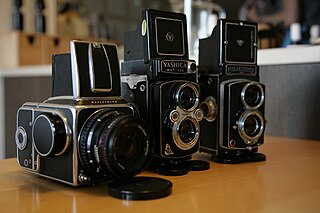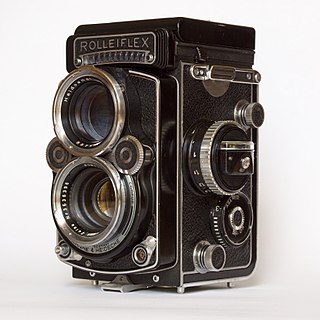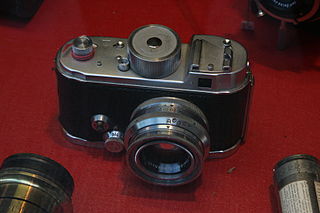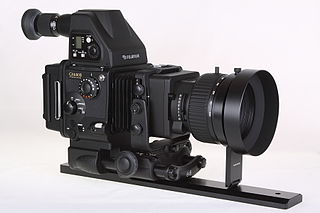
A single-lens reflex camera (SLR) is a camera that typically uses a mirror and prism system that permits the photographer to view through the lens and see exactly what will be captured. With twin lens reflex and rangefinder cameras, the viewed image could be significantly different from the final image. When the shutter button is pressed on most SLRs, the mirror flips out of the light path, allowing light to pass through to the light receptor and the image to be captured.

A camera is an optical instrument that captures a visual image. At a basic level, cameras consist of sealed boxes, with a small hole that allows light through to capture an image on a light-sensitive surface. Cameras have various mechanisms to control how the light falls onto the light-sensitive surface. Lenses focus the light entering the camera. The aperture can be narrowed or widened. A shutter mechanism determines the amount of time the photosensitive surface is exposed to light.

A twin-lens reflex camera (TLR) is a type of camera with two objective lenses of the same focal length. One of the lenses is the photographic objective or "taking lens", while the other is used for the viewfinder system, which is usually viewed from above at waist level.

Victor Hasselblad AB is a Swedish manufacturer of medium format cameras, photographic equipment and image scanners based in Gothenburg, Sweden. The company originally became known for its classic analog medium-format cameras that used a waist-level viewfinder. Perhaps the most famous use of the Hasselblad camera was during the Apollo program missions when the first humans landed on the Moon. Almost all of the still photographs taken during these missions used modified Hasselblad cameras. In 2016, Hasselblad introduced the world's first digital compact mirrorless medium-format camera, the X1D-50c, changing the portability of medium-format photography. Hasselblad produces about 10,000 cameras a year from a small three-storey building.

A press camera is a medium or large format view camera that was predominantly used by press photographers in the early to mid-20th century. It was largely replaced for press photography by 35mm film cameras in the 1960s, and subsequently, by digital cameras. The quintessential press camera was the Speed Graphic. Press cameras are still used as portable and rugged view cameras.
Robot is a German imaging company known originally for clockwork cameras, later producing surveillance (Traffipax) and bank security cameras. Originally created in 1934 as a brand of Otto Berning, it became part of the Jenoptik group of optical companies in 1999. In 2002 the company changed its name from Robot Foto & Electronic to ROBOT Visual Systems GmbH.

Medium format has traditionally referred to a film format in photography and the related cameras and equipment that use film. Nowadays, the term applies to film and digital cameras that record images on media larger than the 24 mm × 36 mm used in 35 mm photography, but smaller than 4 in × 5 in.

The Brownie was a series of cameras made by Eastman Kodak. Released in 1900, it introduced the snapshot to the masses. It was a basic cardboard box camera with a simple convex-concave lens that took 2 1/4-inch square pictures on 120 roll film. It was conceived and marketed for sales of Kodak roll films. Because of its simple controls and initial price of $1 along with the low price of Kodak roll film and processing, the Brownie camera surpassed its marketing goal.

The Holga is a medium format 120 film camera, made in Hong Kong, known for its low-fidelity aesthetic.

The Diana camera is a plastic-bodied toy camera using 120 rollfilm and 35 mm film. The camera has a simple plastic meniscus lens. Originally marketed as an inexpensive novelty gift item, the Diana has been used to specifically take soft focus, impressionistic photographs somewhat reminiscent of the Pictorialist Period of artistic photography, branded in contemporary times as lomography.
Mamiya Digital Imaging Co., Ltd. is a Japanese company that manufactures high-end cameras and other related photographic and optical equipment. With headquarters in Tokyo, it has two manufacturing plants and a workforce of over 200 people. The company was founded in May 1940 by camera designer Seiichi Mamiya and financial backer Tsunejiro Sugawara.

Rolleiflex is the name of a long-running and diverse line of high-end cameras originally made by the German company Franke & Heidecke, and later Rollei-Werke.
Kiev is a Soviet and Ukrainian brand of photographic equipment including cameras manufactured by the Arsenal Factory in Kiev, Ukraine. The camera nameplates show the name "KIEV", with older cameras using "КИЕВ" or "КИЇВ" in Cyrillic.

When setting photoflash exposures, the guide number (GN) of photoflash devices is a measure photographers can use to calculate either the required f‑stop for any given flash-to-subject distance, or the required distance for any given f‑stop. To solve for either of these two variables, one merely divides a device's guide number by the other.

The SX-70 is a folding single lens reflex Land camera which was produced by the Polaroid Corporation from 1972 to 1981.

The Robot II was a mechanical 135 film camera by Robot introduced in 1938. It was a slightly larger camera than the Robot I, with some significant improvements but still using the basic mechanism. Among the standard objectives were 3 cm Zeiss Tessar and a 33⁄4 cm Zeiss Tessar in 1:2,8 and 1:3,5 variations, a 1:2,0/40 mm Zeiss Biotar and 1:4/7,5 cm Zeiss Sonnar.
The Mamiya 6 is a medium-format rangefinder system camera manufactured by Mamiya. It was introduced in 1989, and the line was discontinued in 1995. The coupled viewfinder windows displays frame lines appropriate to the lens mounted. The lens mount partially collapses when the camera is not in use, making it more compact. The camera has a built-in dark slide that allows the electronic leaf shutter lenses to be changed with film in the camera. It can operate in auto exposure, auto exposure lock, and manual modes. It captures twelve 6 cm × 6 cm images on 120 film rolls and 24 on 220 film. The camera also features a self-timer, hot shoe, and flash synchronization terminal.

The Fuji GX680 is a series of single lens reflex system cameras for medium format film produced by Fujifilm with interchangeable camera lenses and interchangeable film holders for the unusual film format 6×8 cm on 120 and 220 roll film. The distinguishing feature of the Fuji GX680 is the articulating front standard, which runs on a rail connecting lens and camera body by a bellows; the interchangeable lens is permanently mounted to a lens board.

Plaubel is a German camera maker, founded in November, 1902, by Hugo Schrader, who learned the technology of cameras and lenses as an apprentice at Voigtländer in Braunschweig in the late 1800s before being employed by a Frankfurt camera and lens manufacturer and distributor, Dr. R. Krügener, whose daughter he married. Hugo Schrader and his wife elected to open their own business, Plaubel & Co., as distributors and makers of cameras and lenses, naming it after his brother-in-law because he thought Plaubel was easier to remember than Schrader.

The Mamiya RB67 is a professional medium format single-lens reflex system camera manufactured by Mamiya. There are three successive models: the RB67 Professional, RB67 Pro-S and RB67 Pro-SD. It is primarily designed for studio use, but can also be used in the field.
















